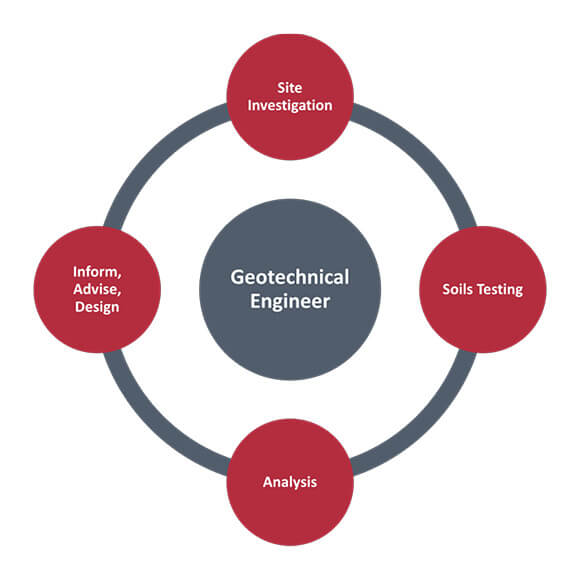The 7-Second Trick For Geotheta
The 7-Second Trick For Geotheta
Blog Article
Facts About Geotheta Revealed
Table of ContentsThe Greatest Guide To Geotheta8 Easy Facts About Geotheta Shown8 Easy Facts About Geotheta ExplainedAbout GeothetaGeotheta - Truths

They conduct site examinations, gather examples, carry out research laboratory examinations, and assess information to evaluate the suitability of the ground for construction projects - Consulting Engineer. Based upon their searchings for, geotechnical designers give recommendations for foundation design, incline security, preserving frameworks, and reduction of geotechnical dangers. They collaborate with other professionals, such as engineers, structural designers, and building and construction teams, to make certain that geotechnical considerations are incorporated right into the total job layout and execution
By assessing the habits and residential or commercial properties of soil and rock, they can identify potential geotechnical threats such as landslides, soil settlement, or incline instability. Their proficiency aids stop failings or mishaps that can endanger lives and property. Right here are some detailed tasks and obligations of a geotechnical designer: Website Examination: Geotechnical designers conduct site investigations to collect data on subsurface problems.
They interpret the information to understand the residential properties and habits of the dirt and rock, including their stamina, leaks in the structure, compaction qualities, and groundwater problems. Geotechnical Analysis and Design: Geotechnical designers evaluate the information collected throughout website investigations to examine the security and viability of the website for building projects. They execute geotechnical calculations and modeling to evaluate variables such as birthing capability, negotiation, slope stability, lateral planet stress, and groundwater circulation.
What Does Geotheta Do?
Foundation Style: Geotechnical designers play a critical function in developing structures that can securely sustain the intended structure. They analyze the soil conditions and tons requirements to figure out the suitable foundation kind, such as superficial structures (e.g., grounds), deep structures (e.g (https://www.gaiaonline.com/profiles/geotheta/46779300/)., piles), or specialized techniques like dirt renovation. They consider factors such as settlement limitations, birthing capability, and soil-structure communication to create ideal structure styles
They review building plans, monitor website activities, and carry out field inspections to validate that the layout referrals are followed. If unexpected geotechnical problems develop, they assess the circumstance and provide suggestions for remediation or modifications to the style. Danger Assessment and Mitigation: Geotechnical designers evaluate geotechnical hazards and threats linked with the project site, such as landslides, liquefaction, or dirt erosion.

Partnership and Communication: Geotechnical designers work very closely with various other professionals entailed in a task, such as designers, structural designers, and building teams. Effective interaction and partnership are vital to incorporate geotechnical factors to consider into the overall job style and construction process. Geotechnical engineers provide technological competence, response inquiries, and guarantee that geotechnical requirements are satisfied.
Indicators on Geotheta You Should Know
Below are some kinds of geotechnical engineers: Structure Engineer: Foundation engineers concentrate on designing and analyzing structures for frameworks. They assess the soil conditions, tons needs, and site characteristics to determine the most proper structure type and design, such as shallow structures, deep structures, or specialized techniques like stack foundations.
They review the elements affecting incline stability, such as soil homes, groundwater conditions, and incline geometry, and establish strategies to stop slope failings and minimize threats. Quake Designer: Quake engineers concentrate on examining and developing frameworks to hold up against seismic forces. They examine the seismic risk of a site, assess dirt liquefaction capacity, and create seismic design standards to make certain the safety and security and strength of frameworks during earthquakes.
They perform area screening, collect samples, and analyze the gathered information to characterize the soil properties, geologic developments, and groundwater problems at a website. Geotechnical Instrumentation Designer: Geotechnical instrumentation designers concentrate on monitoring and measuring the behavior of soil, rock, and frameworks. They install and preserve instrumentation systems that check factors such as soil settlement, groundwater levels, incline motions, and structural displacements to examine efficiency and offer early warnings of prospective issues.
The Main Principles Of Geotheta
They carry out examinations such as triaxial tests, combination tests, direct shear examinations, and leaks in the structure examinations to collect data for geotechnical analysis and style. Geosynthetics Engineer: Geosynthetics engineers specialize in the design and application of geosynthetic products, such as geotextiles, geogrids, and geomembranes. They make use of these materials to boost dirt stability, reinforce inclines, supply drainage options, and control disintegration.
They often tend to be investigatory individuals, which implies they're intellectual, introspective, and investigative. They are curious, methodical, reasonable, analytical, and logical. Some of them are likewise social, indicating they're kind, generous, participating, person, caring, helpful, understanding, sensible, and friendly - Geotechnical Engineers.
In the workplace environment, geotechnical designers make use of specialized software program devices to carry out computations, produce layouts, and evaluate data. They prepare reports, review job specs, interact with customers and group members, and coordinate task tasks. The office setup gives a conducive setting for research, evaluation, and collaboration with other experts associated with the project.
The Facts About Geotheta Uncovered
They frequently check out project sites to conduct website examinations, assess geotechnical conditions, and gather information for evaluation. These sees include traveling to various places, occasionally in remote or challenging surfaces. Geotechnical designers may execute soil sampling, conduct examinations, and screen building and construction activities to ensure that the geotechnical facets of the job are being carried out correctly.
Geotechnical engineers likewise work in specialized geotechnical research laboratories. Geotechnical lab designers function thoroughly in these click over here atmospheres, dealing with testing equipment, running instruments, and taping data.
Report this page